Table of Contents
Transpiration In Plants:
What is Transpiration?
Transpiration may be defined as loss of water in the form of water vapors, from aerial organs of living plants.
Although plants absorb large quantities of water, through their roots, from the soil yet a very little quantity of it is utilized for maintenance of their life. The rest of the absorbed water is lost from the plant either in the form of vapor or liquid. The loss of water from the plants in the form of vapors is called transpiration while the loss of water in the form of liquid is called guttation. About 98% of the water absorbed by the plants is evaporated from the aerial parts of the plants and is diffused into the atmosphere.
Types of Transpiration:
Transpiration occurs from all the exposed parts of the plants. Maximum transpiration occurs through leaves. It is called foliar transpiration. About 99% of the total transpiration is foliar. The remaining 1% occurs through the stem, flowers, fruits, etc. Transpiration through the stem is called cauline transpiration. Foliar transpiration and part of cauline transpiration is of further two types, stomatal and cuticular. Transpiration from older stems is also of two kinds, lenticular and bark transpiration.
Cuticular Transpiration or Epidermal Transpiration:
It occurs through the cuticle of the epidermis. Cuticular transpiration depends upon the thickness of the cuticle. The cuticle is a noncellular covering of cutin and wax that lies on the exposed surface of epidermal cells. The cuticle is thin in mesophytic and shade-loving plants. In such plants, cuticular transpiration constitutes 50% of the total transpiration. In other plants, its proportion is 3-10%. Cuticular transpiration continues throughout day and night.
Stomatal Transpiration:
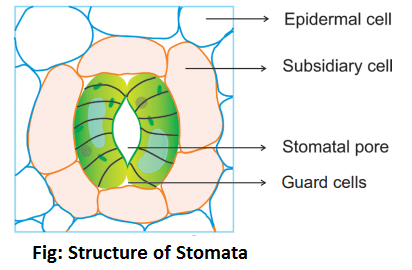
This transpiration takes place through permanent minute openings present on the leaves surface called stomata. Of the total water lost from the plants, 50-97% is lost through stomatal transpiration. The stomatal opening is surrounded by kidney-shaped epidermal cells called guard cells. Each guard cell has a nucleus, chloroplasts, and cytoplasm. The inner wall of the guard cell is thick white its outer wall is thin. Each guard cell is surrounded by a few specialized epidermal cells called accessory cells or subsidiary cells.
On average there are about 50-300 stomata per square millimeter of leaf surface area. The least number of stomata observed so far is 14 per sq. mm. surface area and the maximum number is about 1038 per sq. min leaf area. The opening and closing of stomata depend on the turgidity of guard cells. When the guard cells are in a turgid state, the stomata opens and when the guard cell is flaccid, the stomata closes.
In grasses, the guard cells are dumb-bell-shaped and their cell walls are thickened only in the middle. In this case also when the guard cells are turgid stomata opens and when these are flaccid, the stomata closes.
Lenticular Transpiration:
In stems of woody plants and trees, the epidermis is replaced by periderm because of secondary growth. In order to provide a gaseous exchange between the living cells and outer atmosphere, some pores which look like
lens-shaped raised spots are present on the surface of the stem called Lenticels. The loss of water from lenticels is very insignificant as it amounts to only 0.1% of the total. It, however, occurs throughout day and night.
Bark Transpiration:
This transpiration takes place through the bark of woody stems. The surface of the bark is generally covered by cork. Cork is largely impermeable to water vapors. However, some diffusion of water vapors does occur. Its percentage out of total transpiration may be up to 0.5%. Bark transpiration continues for 24 hours a day.
Factors Affecting the Rate of Transpiration:
There are many internal and external factors that affect transpiration-
External (Environmental) Factors:
- Temperature- Higher the temperature, the more is the transpiration because the rate of evaporation of water from the mesophyll cell increases the transpiration rate. The temperature of the leaf gets raised by absorbing the sunlight. This also increases the vaporization of water in the leaf which in turn increases the transpiration.
- Light- Light affects transpiration by influencing the opening and closing of stomata. In most mesophytes, it causes stomata to open and hence increases the water loss from the plant.
- Wind- Wind increases transpiration by removing the saturated air around the leaves and bringing in drier air. However, high speed wind sometimes reduces transpiration due to closure of stomata and cooling of leaf surface.
- Atmospheric Humidity- If the outer air is humid it will reduce the diffusion of water vapor from intercellular spaces of the leaf to the outer atmosphere. In other words, the rate of transpiration decreases with the increase in relative humidity of the atmosphere. The rate of transpiration is increased by lowering the atmospheric humidity.
- Available Soil Water- When the soil gets dry, the amount of available water also decreases. The soil solution becomes more concentrated and the rate of absorption by the cells decreases. This leads to a reduction in transpiration. Wilting takes place when a plant loses more water by transpiration than it can take up from the roots. The plant is said to suffer from water stress. In such a situation, stomata close quickly to keep the water loss to the minimum.
- Atmospheric Pressure- Lowering of atmospheric pressure reduces the density of the environment which permits more rapid diffusion of water vapors. For example- plants growing at hills show a higher rate of transpiration, but this effect is neutralized by low temperature prevailing at the hills, with the result transpiration is normal in the plants growing on the hills.
Internal (Plant) factors:
- Root-Shoot Ratio- The rate of transpiration depends upon the efficiency of roots to absorb water and on leaves to evaporate it. The rate of transpiration increase directly with an increase in the root-shoot ratio.
- Leaf Area- The increase in leaf area is generally associated with an increase in the rate of transpiration. However, this is not always the case. There is no relation between leaf area and water loss. In large plants, transpiration may be higher per plant, though on unit area basis, the rate of transpiration is more in the smaller plants than larger ones.
- Leaf Structure- The following anatomical features reduces the rate of transpiration:
- Thick cuticle on the surface of plant parts.
- Wax, resin and suberin coating on the surface of plant parts.
- Compact mesophyll cells in the leaves.
- Reduction in number of stomata.
- Sunken stomata.
- Age of Plants- Rate of transpiration is slow at the seedling stage, maximum at maturity, and gradually decreases near the senescence.
Significance of Transpiration (Transpiration as a Necessary Evil):
It is now well known that transpiration is the most important excretory mechanism in plants but at the same time it is not of many advantages as most of the water absorbed by the plant is lost through this process.
Advantages of Transpiration:
- It controls the rate of absorption of water.
- It helps in the mineral absorption and ascent of sap- Rapid rate of transpiration helps the upward movement of water and minerals through the xylem ducts.
- It regulates the plant temperature- Transpiration prevents the heating of plant leaves (heat burns) during excessive day temperature. It causes a cooling effect.
Disadvantages of Transpiration:
- Nearly 98% of the total water absorbed by the plants is lost in the form of vapors, only 2% or less than that is actually utilized in growth and plant metabolism.
- Transpiration often results in water deficits which cause injury to the plants by desiccation.
- Rapid transpiration causes midway leaf water deficits (temporary wilting). Under certain conditions when the rate of transpiration exceeds the rate of absorption, the plants face an internal water deficit. If such a condition continues for some time, permanent water deficit (wilting) may develop which causes injury to the plants.
- Many xerophytes have to develop their structural modifications in order to reduce transpiration viz., thick hypodermis, reduction of leaves, reduction of stomatal number, sunken stomata, etc. These modifications are an extra burden on the plants.
- Deciduous trees have to shed their leaves to check transpiration.
Besides all the disadvantages, the process of transpiration is unavoidable because of the anatomical structure of the leaves. Since stomata are required for gaseous exchange in photosynthesis and respiration, the loss of water vapors through them cannot be avoided. Therefore, Curtis (1926) truly called ‘transpiration as a necessary evil’.
- Difference between prokaryotic and eukaryotic cell
- Difference Between C3 Plants And C4 Plants
- What is vernalization in plants?
- Ecological Succession or Biotic Succession
- Ecological Pyramids
- Tamil Board: Living World
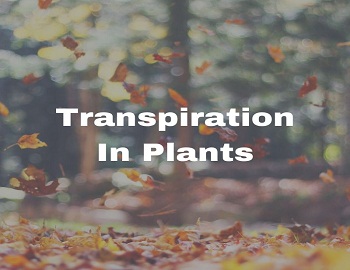
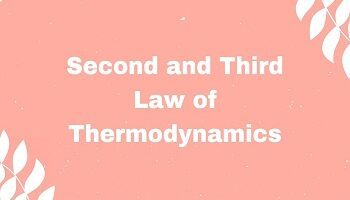


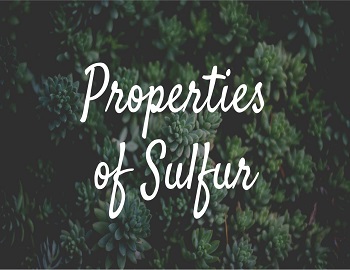


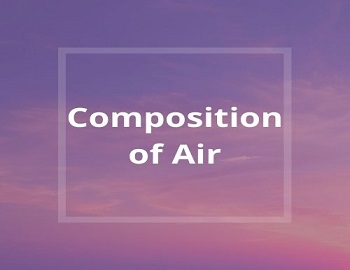
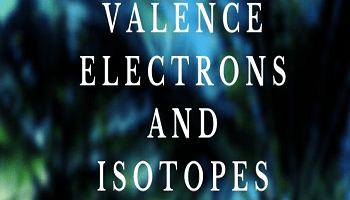
Comments (No)